Cheshire Cat
| Cheshire Cat | |
|---|---|
| Alice's Adventures in Wonderland character | |
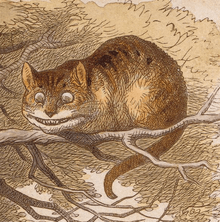 The Cheshire cat as illustrator John Tenniel envisioned it in the 1865 publication | |
| Created by | Lewis Carroll |
| Voiced by |
Sterling Holloway Tony Pope (Disneyland attractions) Jim Cummings (current) Keith David (Once Upon A Time in Wonderland) Stephen Fry |
| Information | |
| Species | Tabby British Shorthair Cat |
| Gender | Male (the Queen of Hearts cries "off with his head" when the cat upsets the king) |
| Quote |
"Most everyone's mad here" "You may have noticed that I'm not all there myself" |
The Cheshire Cat (/ˈtʃɛʃər/ or /ˈtʃɛʃɪər/) is a fictional cat popularised by Lewis Carroll in Alice's Adventures in Wonderland and known for its distinctive mischievous grin. While most often celebrated in "Alice"-related contexts, the Cheshire Cat predates the 1865 novel and has transcended the context of literature and become enmeshed in popular culture, appearing in various forms of media, from political cartoons to television, as well as cross-disciplinary studies, from business to science. One of its distinguishing features is that from time to time its body disappears, the last thing visible being its iconic grin.
Origins
There are numerous theories about the origins of the phrase "Grinning like a Cheshire Cat" in English history.
- A possible origin of the phrase is one favoured by the people of Cheshire, a county in England which boasts numerous dairy farms; hence the cats grin because of the abundance of milk and cream.[1]
- According to Brewer's Dictionary, "The phrase has never been satisfactorily accounted for, but it has been said that cheese was formerly sold in Cheshire moulded like a cat that looked as though it was grinning".[2] The cheese was cut from the tail end, so that the last part eaten was the head of the smiling cat.[3]
- In 1853, Samuel Maunder explained:
This phrase owes its origin to the unhappy attempts of a sign painter of that country to represent a lion rampant, which was the crest of an influential family, on the sign-boards of many of the inns. The resemblance of these lions to cats caused them to be generally called by the more ignoble name. A similar case is to be found in the village of Charlton, between Pewsey and Devizes, Wiltshire. A public-house by the roadside is commonly known by the name of The Cat at Charlton. The sign of the house was originally a lion or tiger, or some such animal, the crest of the family of Sir Edward Poore.[4]
- Its first appearance in literature was in the 18th century. A classical dictionary of the vulgar tongue (1788) by Francis Grose (The Second Edition, Corrected and Enlarged, London) contains the following entry: "CHESHIRE CAT. He grins like a Cheshire cat; said of any one who shows his teeth and gums in laughing."
- The phrase appears again in print in John Wolcot's pseudonymous Peter Pindar's Pair of Lyric Epistles (1792): "Lo, like a Cheshire cat our court will grin."
- The phrase also appears in print in William Makepeace Thackeray's The Newcomes (1855) ("That woman grins like a Cheshire cat.").
Lewis Carroll's character
The Cheshire Cat is now largely identified with the character of the same name in Lewis Carroll's novel Alice's Adventures in Wonderland. Alice first encounters the Cheshire Cat at the Duchess' house in her kitchen, and later on the branches of a tree, where it appears and disappears at will, and engages Alice in amusing but sometimes perplexing conversation. The cat sometimes raises philosophical points that annoy or baffle Alice; but appears to cheer her when it appears suddenly at the Queen of Hearts' croquet field; and when sentenced to death, baffles everyone by having made its head appear without its body, sparking a debate between the executioner and the King and Queen of Hearts about whether a disembodied head can indeed be beheaded. At one point, the cat disappears gradually until nothing is left but its grin, prompting Alice to remark that 'she has often seen a cat without a grin but never a grin without a cat'.[5]
According to recent analysis by scholar David Day, Lewis Carroll's cat was Reverend Dr Edward Bouverie Pusey, Oxford professor of Hebrew, and Carroll's mentor.[6]
The name Pusey was suggested by Alice's deferential address of the cat as "Cheshire Puss". Pusey was an authority on the fathers of the Christian Church, and in Carroll's time Pusey was known as the Patristic Catenary (or chain), after the chain of authority of Church patriarchs. As a mathematician, Carroll would have been well familiar with the other meaning of catenary: the curve of a horizontally-suspended chain, which suggests the shape of the cat's grin.[7]
RIDDLE: What kind of a cat can grin?ANSWER: A Catenary.
— David Day, Queen's Quarterly (2010)
Source of imagery
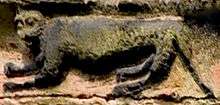

There are many other suggestions that Carroll found inspiration for the name and expression of the Cheshire Cat in the 16th century sandstone carving of a grinning cat, on the west face of St. Wilfrid's Church tower in Grappenhall, a village adjacent to his birthplace in Daresbury, Cheshire.
Lewis Carroll's father, Reverend Charles Dodgson, was Rector of Croft and Archdeacon of Richmond in North Yorkshire, England, from 1843 to 1868; Carroll lived here from 1843 to 1850.[8] Historians believe Lewis Carroll's Cheshire Cat in the book Alice in Wonderland was inspired by a carving in Croft church.[9]
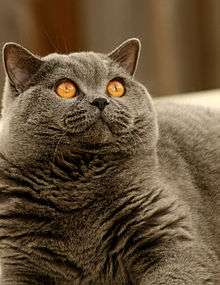
Another possible inspiration was the British Shorthair: Carroll saw a representative British Shorthair illustrated on a label of Cheshire cheese.[10] The Cat Fanciers' Association profile reads: "When gracelessness is observed, the British Shorthair is duly embarrassed, quickly recovering with a 'Cheshire cat smile'”.[11]
In 1992, members of the Lewis Carroll Society attributed it to a gargoyle found on a pillar in St. Nicolas Church, Cranleigh, where Carroll used to travel frequently when he lived in Guildford (though this is doubtful as he moved to Guildford some three years after Alice's Adventures in Wonderland had been published) and a carving in a church in the village of Croft-on-Tees, in the north east of England, where his father had been rector.[12]
Carroll is believed to have visited St. Christopher's church in Pott Shrigley, Cheshire, which has a stone sculpture most closely resembling the pictorial cat in the book.
Cultural references
The Cheshire Cat character has been re-depicted by other creators and used as the inspiration for new characters, primarily in screen media (film, television, video games) and print media (literature, comics, art). Other non-media contexts that embrace the Cheshire Cat include music, business, and science.
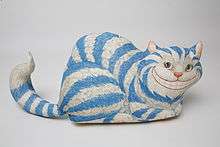
Prior to 1951 when Walt Disney released an animated adaptation of the story (see below), there were few post-Alice allusions to the character. Martin Gardner, author of The Annotated Alice, wondered if T. S. Eliot had the Cheshire Cat in mind when writing Morning at the Window but notes no other significant allusions in the pre-war period.[13]
Images of and references to the Cheshire Cat cropped up with increasing frequency in the 1960s and 1970s, along with more frequent references to Carroll's works in general. (See generally the lyrics to White Rabbit by the rock group Jefferson Airplane).[14][15] The Cheshire Cat appeared on LSD blotters as well as in song lyrics and popular fiction.[16][17]
Film adaptations
Disney's 1951 animated film, Alice in Wonderland
In the 1951 Disney animated film, Alice in Wonderland, the Cheshire Cat is depicted as an intelligent and mischievous character that sometimes helps Alice and sometimes gets her into trouble. He frequently sings the first verse of the Jabberwocky poem. The animated character was voiced by Sterling Holloway (Alice in Wonderland) and Jim Cummings (2004–present).
Disney's 1999 TV film, Alice in Wonderland
In the 1999 television adaptation of Carroll's books, the Cheshire Cat is portrayed by Whoopi Goldberg. She fully acts as an ally and friend to Alice.
Tim Burton for Disney's 2010 live-action film, Alice in Wonderland
The Cheshire Cat appears in Walt Disney's 2010 Alice in Wonderland, directed by Tim Burton. British actor Stephen Fry voices the character.[18] In the movie, Cheshire (as he is often called; or sometimes 'Chess') binds the wound Alice suffered earlier by the Bandersnatch and guides her to Tarrant Hightopp, the Mad Hatter and Thackery Earwicket, the March Hare. He is blamed by the Hatter for desertion when the White Queen is deposed by the Red; but later impersonates the Hatter when the latter is sentenced to decapitation. Throughout his appearances, 'Chess' is able to make himself intangible or weightless, as well as invisible (and thus to survive decapitation), and is usually shown in mid-air, at shoulder-height to human-sized characters.[19] In the video game adaptation of the movie, Chess is a playable character who can not only turn himself invisible, but other objects around him as well.
Cross-film comparison
Each major film adaptation of Lewis Carroll's tale represents the Cheshire Cat character and his traits uniquely.
| Screen Media Adaptation | Distribution Medium | Cheshire Cat's Appearance | Cheshire Cat's Behavior | Image |
|---|---|---|---|---|
| Alice in Wonderland (1951 film)[20] | Film (Alice in Wonderland, traditional animation by Walt Disney Studios)[20] | Thick build and a primarily pink coat with purple stripes. Wide smile and close-set, piercing yellow eyes. Character always depicted in good lighting with strong visibility, unlike other adaptations which obscure or shadow him | Mischievous, and takes pleasure in misdirecting Alice. He is able to dislocate his head from his body (does so in jest), but is also capable of invisibility, and frequently enters and exits the scene with all parts faded away except for his grin or eyes. |  |
| Adventures in Wonderland (1991 TV show)[21] | Televised broadcast (Adventures in Wonderland, TV series through 1995) [21] | Closer resemblance to a tiger or lioness than a house cat. Coat has a white base with stripes painted in a violet accent color. Form possesses human-like mouth and facial structure | A sarcastic and playful rendition of the character. In this adaptation, the Cheshire Cat has the ability to appear and disappear in any location. He is quick to play practical jokes on other the characters in the show. | |
| Alice in Wonderland (1999 made-for-TV movie)[22] | Television Film[22] | A fluffy grey cat with a human face and feline features. | A grinning cat who teaches Alice "the rules" of Wonderland. Her favorite pastime is appearing and disappearing. | |
| Alice in Wonderland (2010 film)[23] | Film (Alice in Wonderland, live-action directed by Tim Burton)[23] | More slender build, with a round head and grey/green coat with several blue/black stripes. Bright aqua eyes (with slit-shaped pupils) and prominent teeth. Often more backlit than other adaptations, with only a faint, luminescent glow (self-generated) bringing his features into view. | Disappearing and reappearing at will, and able even to change his size, levitate himself, assume the appearances of other characters, and become intangible at will. The cat plays a few jokes and toys with the other characters, but is helpful on a few occasions. He speaks in a slow and fluid manner. | 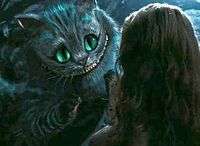 |
In addition to the Cheshire Cat's appearances in films central to its Lewis Carroll origins, the Cheshire Cat has been featured in other cinematic works:
- The late filmmaker Chris Marker gave his monumental documentary on the New Left movement of 1967–1977, Le fond de l'air est rouge (1977), the English title Grin Without a Cat. Like the original, it signifies that revolution was in the air but failed to take root. In the film, it is also stated: a spearhead without a spear, a grin without a cat.
- The Disney version of the character can also be spotted during the final scene of the film Who Framed Roger Rabbit (1988). The Cheshire Cat is heard singing the poem "Jabberwocky" before he materialises in front of Alice.
- The Cheshire Cat made non-speaking cameos in House of Mouse.
- The Transporter Refueled 2015 movie: The DJ at the Full Moon Club wears a giant Cheshire Cat head and only has a minute or so of screen time.
Television adaptations
The Cheshire Cat has been seen by television audiences in a broadcast spin-off:
- The Cheshire Cat appears in Once Upon a Time in Wonderland (a spin-off of Once Upon a Time) voiced by Keith David.[24] While looking for the Mad Hatter's house from the trees, Alice encounters the Cheshire Cat in giant form where the Red Queen had promised him that Alice would be good food for him. Both of them ended up engaging each other in combat until the Knave of Hearts arrived and threw a piece of one mushroom side into his mouth which shrank him back to normal size as the Cheshire Cat leaves.
Video game adaptations
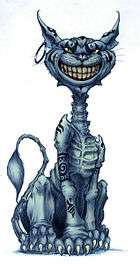
The Cheshire Cat appears as an avatar character in several video games:
- The character Luka in video game Bayonetta is nicknamed "Cheshire" by the titular character, which is exhibited through his ability to appear or disappear at many locations throughout the game by use of a grappling hook.
- In the video games American McGee's Alice (2000); and the sequel Alice: Madness Returns (2011), the Cheshire Cat is portrayed as an enigmatic, yet wise guide for Alice in the corrupted Wonderland. In keeping with the twisted tone of the game, the Cheshire Cat is mangy and emaciated in appearance. His voice was provided by Roger L. Jackson, who also voiced the Mad Hatter and The Jabberwock in the game.
- In the Disney/Square Enix video game series Kingdom Hearts, loosely based on the Alice books as a subsequent adventure, the Cheshire Cat offers Sora, Donald and Goofy clues to prove that the Heartless attempted to steal the Queen of Hearts' heart and not Alice, along with the blizzard spell.
- The Cheshire Cat appears in the game Jazz Jackrabbit 2 as an alternatively appearing and reappearing platform.
- In the Alice in Wonderland stage in Disney's Villains' Revenge the grin of the Cheshire Cat appears in the maze as the player seeks out Alice's missing head.
- In Kinect: Disneyland Adventures the Cheshire Cat briefly appears during the Alice in Wonderland mini-game during the player's free fall down the rabbit hole.
Print media adaptations
Novels
The Cheshire cat has inspired other characters in the publishing world:
- Cheshire cats is the name given to the widespread genetically engineered cats appearing in Paolo Bacigalupi's biopunk novel The Windup Girl (2009).
- In Frank Beddor's The Looking Glass Wars series of novels, the Cat is Redd's top assassin. The Cat has butcher knife claws and can change from his true form to the form of a small black kitten. He initially has nine lives, but loses all but one by the end of the book.
- In the Thursday Next series by Jasper Fforde, the Cheshire Cat is an overseer in the Great Library, a library within the "book-world" which contains copies of every book ever written. However, due to "boundary changes", the Cat is renamed the "Unitary Authority of Warrington Cat".
- The novel Mirror by Graham Masterton is based on the story of Through The Looking Glass and features the Cheshire Cat as a familiar of Satan
Comics
American comics
The Cheshire Cat can be spotted in several comics by major American publishers:
- In DC Comics, the New Goddess Malice Vundabar, niece of the villain Virman Vundabar, resembles Alice and controls a carnivorous creature called Chessure, that looks like nothing more than a grinning face. Cheshire is also the codename of the human assassin Jade Nguyen, who has a daughter with the heroic archer Roy "Speedy" Harper.
- In Marvel Comics, Cheshire Cat is a foe of Luke Cage. An ally of fellow Cage enemy Big Brother, Cheshire Cat is able to make himself invisible and teleport. His physical appearance and manner of speaking are both evocative of a classic hep cat, despite debuting in 1976.
- In Peanuts, Snoopy is featured performing the "Cheshire Beagle" trick several times, whereby he grins widely while the rest of his body disappears.
Anime and manga
The Cheshire Cat character has been embraced by the world of Japanese comics (Manga) and animation (Anime), where several odes to the Cheshire Cat have been observed:
- The Cheshire Cat appears in the 1983 animated TV series Fushigi no Kuni no Alice. It is shown in one episode that he can lose his power to disappear if he sneezes, and that he needs blue flowers to restore it. Another Cheshire Cat appears as the cat of the Duchess but isn't magical.
- In CLAMP's Miyuki-Chan in Wonderland, the Cheshire Cat appears as a catgirl.
- In the Alice in the Country of Hearts or Heart no Kuni no Alice series of manga and anime, the Cheshire Cat appears as a catboy punk called Boris Airay. He has tattoos and body piercings, wears exposing outfits, a collar and chain, and a boa. He also has a fetish with weapons, especially guns. In the series, like many of the other characters, he falls in love with Alice.
- The villain Schrödinger, in the manga Hellsing, is described by his commanding officer, The Major, as the "smiling cat of Wonderland".
- In the anime and manga Pandora Hearts, one of the main characters, Alice, had a pet cat that died, but returns 100 years later as a chain in a realm created by one of Alice's memories. He came to call himself the Cheshire Cat, and had a more human-like appearance, or a catboy look.
- In the sixth episode of Serial Experiments Lain, Lain refers to a Wired user with an avatar consisting of disembodied, wide-grinning lips as a Cheshire Cat wannabe. Lain's friend, Alice, was named after the book's protagonist.
- The Pokémon character Gengar has the Cheshire Cat's mischievous smile.
- In the episode 'Haruhi in Wonderland' of the popular anime/manga Ouran High School Host Club, the twins Hikaru and Kaoru Hitachiin each dress up as the Cheshire Cat, allowing them to 'teleport' from one place to another. They keep up this charade until Haruhi tells them to come out. She cannot concentrate as they are making her dizzy.
- In the anime and manga Project ARMS one of the Keith has the ARM of the Cheshire Cat, which allows him to instantaneously 'teleport' at will.
- The Cheshire Cat appears in the Kingdom Hearts Manga, fulfilling mostly the same role as in the game. Notable diversions, though, are that he gives Sora the power of magic in general-as opposed to just Blizzard-and an implication that he turned down Maleficent's offer that she made to her fellow Disney Villains.
- In the episode 'Ciel in Wonderland' of the anime "Black Butler", the grim reaper Grell Sutcliff takes on the role of the Cheshire Cat. In this form, Grell no longer possesses the red coat taken from Madam Red, but gains pink-and-magenta cat ears and a matching cat tail and scarf, along with an ability to appear and disappear at will.
Art
The Cheshire Cat has transcended screens to be featured in fine art:
- An exhibit called The Cheshire Cat at the Exploratorium in San Francisco, created by Bob Miller in 1978, features a mirrored eyepiece that allows visitors to look at a picture of the Cheshire Cat's face with one eye, while the other eye sees a reflection of a white screen to the side.[25]
Other media and cross-disciplinary references
In music
Several musical references to the Cheshire cat can be found song lyrics and album titles:
- Pop Band [Grinning Sometimes] 1983-1985. Artwork
- Pop punk band Blink-182's debut studio album is called Cheshire Cat (1994)
- Hypnogaja's song "Looking glass" states that "There's a cat that smiles like the crescent moon".
- The Cheshire Cat is part of the chorus of Victim Effect's song "Alice Alice".
- French singer Nolwenn Leroy produced the album Le Cheshire Cat et moi in (2009)
- Radiohead's "Jigsaw Falling Into Place" contains the lyric "You've got a Cheshire cat grin".
- Though never mentioned by name, the Cheshire Cat is a central character in Vixy's "The Girl Who's Never Been".
- Stephan Nance's "Immunodeficiency" contains the lyric "Conspicuously grinning like the cat who's in the story life we've led".
- Cheshire Cat Smile was released in 2006 by Milburn.
- Taylor Swift's "Wonderland" from the deluxe edition of her 1989 album contains the lyric "Didn't you calm my fears with the Cheshire Cat's smile?".
- Korean singer IU's extended play Chat-Shire name refers Cheshire was released in 2015.
- Korean girlgroup CLC announced on June 21, 2016, the name of their official fanclub: CHESHIRE. The color and yellow eyes on the fanclub logo were inspired by the Cheshire Cat and its colors as in the movie Alice in Wonderland (1951).
In business
Pubs in the United Kingdom bear the name of the Cheshire Cat:
- "The Cheshire Cat" is the name of two public houses in the county of Cheshire; one near Stockport[26] and another on the A41 just south of Chester.[27]
In science
The scientific community has embraced the Cheshire Cat as a metaphor to explain several scientific phenomena:
- The Cheshire Cat effect, as described by Sally Duensing and Bob Miller, is a binocular rivalry which causes stationary objects seen in one eye to disappear from view when an object in motion crosses in front of the other eye.[28] Each eye sees two different views of the world, sends those images to the visual cortex where they are combined, and creates a three-dimensional image. The Cheshire Cat effect occurs when one eye is fixated on a stationary object, while the other notices something moving. Since one eye is seeing a moving object, the brain will focus on it, causing parts of the stationary object to fade away from vision entirely.[29]
- In another scientific context, catalytic RNAs have been deemed Cheshire cats. This metaphor is used to describe the fading of the ribonucleotide construct, which leaves behind a smile of only the mineral components of the RNA catalyst.[30]
- Similarly, the Cheshire Cat has been used out of its traditional context to help define another scientific phenomenon: the "Cheshire Cat" escape strategy. When Coccolithophore—a successful ocean algae—is able to resist the haploid phase of its life cycle it escapes meiosis and its dominant diploid genes are passed on in a virus-free environment, freeing the host from the danger of infection during reproduction.[31] The algae escape death (beheading) by means of disappearance (vanishing his head):
...[T]aken from Lewis Carroll, we liken this theory to the strategy used by the Cheshire Cat in Alice's Adventures in Wonderland of making its body invisible to make the sentence "off with his head" pronounced by the Queen of Hearts impossible to execute...CC dynamics, which rely to some extent on separation of the sexual processes of meiosis and fusion in time and/or space, release the host from short-term pathogen pressure, thus widening the scope for the host to evolve in other directions.
- Other gestures to the Cheshire Cat's tropes of disappearance and mystique have been seen in scientific literature coming from the field of Physics. "The Cheshire Cat" is a phenomenon in quantum mechanics in which a particle and its property behave as if they are separated,[32] or when a particle separates from one of its physical properties.[33] To test this idea, researchers used an interferometer where neutron beams passed through silicon crystal. The crystal physically separated the neutrons and allowed them to go to two paths. Researchers reported "the system behaves as if the neutrons go through one beam path, while their magnetic moment travels along the other."[33]
- Similar to the term "quantum Cheshire Cat", in quantum mechanics, scientists have coined the term Schrödinger's cat. In this quantum phenomenon, a cat is both alive and dead inside a box. This is known as a superposition, and again points to the separation between the Cheshire Cat and his grin.[33]
- The Cheshire cat's grin has inspired scientists in their naming of visual phenomena. A merger of galaxy groups in the constellation Ursa Major is nicknamed "Cheshire Cat galaxy group" by Astronomers due to its suggestive appearance.[34]
Notes
- ↑ "Cheshire cat – Definition and More from the Free Merriam-Webster Dictionary". merriam-webster.com. 2011. Retrieved 8 August 2011.
- ↑ As stated in Martin Gardner's Annotated Alice
- ↑ Gardner, Martin (1999). The Annotated Alice: Alice's adventures in Wonderland & Through the looking glass. W.W. Norton. ISBN 0-393-04847-0.
- ↑ Samuel Maunder, The Treasury of Knowledge and Library Reference, Edition 12 Publisher: Longman, Orme, Brown, Green, & Longmans, 1853, page 396
- ↑ Annotated Alice; the statement "a grin without a cat" is a reference to mathematics dissociating itself completely from the natural world.
- ↑ David Day, "Oxford in Wonderland" Queen's Quarterly Vol. 117 Issue 3 (Fall 2010): 403+
- ↑ David Day, "The Cheshire Cat’s Grin: Solving the greatest mystery of Wonderland, 150 years later." The Walrus September 2015.
- ↑ Clark, Ann (1979). Lewis Carroll: A Biography. London: J. M. Dent & Sons. ISBN 0-460-04302-1.
- ↑ Gardner, Martin (2000). The Annotate Alice: The Definitive Edition. New York / London: W.W. Norton and Company. p. 62. ISBN 0-393-04847-0.
- ↑ Stewart, Ian (2010). Professor Stewart's Hoard of Mathematical Treasures. Profile Books. p. 67.
- ↑ Geyer, Georgie Anne. When Cats Reigned Like Kings: On the Trail of the Sacred Cats. Transaction Publishers. p. 219.
- ↑ "Cheshire Cat found by fans of Lewis Carroll". The Toronto Star. Toronto ON. Reuters. 8 July 1992. p. C24.
- ↑ Gardner, Martin (1999). The Annotated Alice: Alice's adventures in Wonderland & Through the looking glass. W.W. Norton. p. 62. ISBN 0-393-04847-0.
- ↑ Brooker, Will (2004). Alice' s Adventures: Lewis Carroll and Alice in Popular Culture. London: Continuum. p. 81. ISBN 0-8264-1433-8. Retrieved 7 July 2008.
- ↑ Roos, Michael (1984). "The Walrus and the Deacon: John Lennon's Debt to Lewis Carroll". Journal of Popular Culture. 18 (1): 19–29. doi:10.1111/j.0022-3840.1984.1801_19.x.
- ↑ Vanessa St Clair (5 June 2001). "A girl like Alice". The Guardian. UK.
- ↑ Real, Willi (2003). "The Use of Literary Quotations and Allusions in: Ray Bradbury, Fahrenheit 451". Retrieved 7 July 2008.
- ↑ Boshoff, Alison (20 February 2010). "Alice's very weird wonderland: Why a behind-the-scenes row might see Tim Burton's most fantastical film yet disappear from cinemas as fast as the Cheshire Cat". Daily Mail. London: Associated Newspapers. Archived from the original on 15 November 2010. Retrieved February 21, 2010.
- ↑ "Alice in Wonderland – Glossary of Terms/Script (early draft)" (PDF). Walt Disney Pictures. JoBlo.com. Archived (PDF) from the original on 15 November 2010. Retrieved March 30, 2010.(early draft of the film script, first started February 2007)
- 1 2 "Alice in Wonderland (1951 film)". IMBD. Retrieved 2 October 2014.
- 1 2 "Adventures in Wonderland (1991 TV show)". IMDB. Retrieved 2 October 2014.
- 1 2 "Alice in Wonderland (TV Movie 1999)". Retrieved 5 October 2014.
- 1 2 "Alice in Wonderland (2010 film)". IMBD. Retrieved 2 October 2014.
- ↑ http://tvline.com/2013/09/05/once-upon-a-time-in-wonderland-cheshire-cat-keith-david/
- ↑ "Exploratorium: Science Snacks: Cheshire Cat". Retrieved 23 March 2009.
- ↑ "Cheshire Cat Stockport – Pub & Bars Information , 150 Middlesex Road". Viewleeds.co.uk. Retrieved 15 August 2011.
- ↑ "The Cheshire Cat in Christleton – Pub Home & About Us". Vintageinn.co.uk. Retrieved 15 August 2011.
- ↑ Duensing, Sally; Miller, Bob (1979). "The Cheshire Cat effect". Perception. 8 (3): 269–273. doi:10.1068/p080269.
- ↑ "Cheshire Cat: Perception Science Project". Exploratorium Science Snacks. Retrieved 18 September 2014.
- ↑ Yarus, Michael (1993). "How many catalytic RNAs? Ions and the Cheshire cat conjecture". The FASEB Journal. 7 (1): 31–39. PMID 8422972. Retrieved 24 September 2014.
- ↑ Frada, Miguel, et al. "The 'Cheshire Cat' escape strategy of the coccolithophore Emiliania huxleyi in response to viral infection." Proceedings of the National Academy of Sciences 105.41 (2008): 15944-15949. http://www.pnas.org/content/105/41/15944.full
- ↑ "Observation of a quantum Cheshire Cat in a matter-wave interferometer experiment". Nature Communications. 5. 29 July 2014. doi:10.1038/ncomms5492. Retrieved 18 September 2014.
- 1 2 3 Morgan, James. "'Quantum Cheshire Cat' becomes reality". BBC News. BBC. Retrieved 24 September 2014.
- ↑ http://apod.nasa.gov/apod/ap151127.html Astronomy Picture of the Day 27th November 2015
References
- Brooker, Will (2004). Alice' s Adventures: Lewis Carroll and Alice in Popular Culture. London: Continuum. ISBN 0-8264-1433-8.
- Gardner, Martin (1999). The Annotated Alice: Alice's adventures in Wonderland & Through the looking glass. W.W. Norton. ISBN 0-393-04847-0.
- Silvey, Anita (2002). The essential guide to children's books and their creators. Houghton Mifflin. ISBN 0-618-19082-1.
External links
| Wikiquote has quotations related to: Cheshire Cat |
| Wikimedia Commons has media related to Cheshire Cat. |
- Cheshire Cat character description
- An article on the Grappenhall carving
- BBC article about the Croft carving